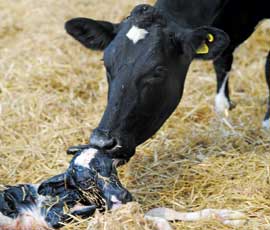Salmonella risk in cows prompts health warning

Vets and farmers are reminding cattle producers of the human and cattle health risks surrounding salmonella infection and urging vigilance for signs of disease.
About 20% of cattle herds are thought to be infected with some kind of salmonella, with the disease commonly being spread by wild birds or bought-in cattle.
Infection can effect any age of cattle, causing scours and pneumonia in calves, and abortion, milk drop and scours in adult cattle – or even death.
The zoonotic element of the disease also means it’s important to put salmonella back on farmers’ radars, believes vet Maarten Boers of the Livestock Partnership.
“It (the disease) shouldn’t be underestimated, especially for those farmers with young families,” he says. Salmonella infection can be particularly severe in the young or old, potentially leading to death.
One West Sussex producer who identified salmonella as the cause of abortion in one of his suckler cows, urges farmers to think more about the disease risk on farm.
“I’ve been feeling sick since Christmas with pains in my kidneys and lethargy. I’m awaiting test results, but I suspect it’s linked to salmonella,” he says. “I’ve never known of salmonella in a beef herd so I was surprised to find it was the cause of abortion.”
agressive strains
The two most aggressive strains of the disease include Salmonella typhimurium and Salmonella dublin. More exotic strains can be introduced by birds excreting on feed and in water troughs.
Buying-in is also a major route of infection and Mr Boers believes all farmers are likely to have introduced disease at some point when purchasing cattle from different sources.
Once cattle are infected with typhus or dublin, they can become carriers of the disease, says Mr Boers. “A cow may look healthy, but begin shedding salmonella during times of stress. It’s virtually impossible to identify carriers, so it’s important to minimise the risk of buying-in by getting a good history of purchased cattle.”
Quarantining stock for three weeks should provide enough time for any carriers to become apparent, as stress from handling or travel may trigger the latent disease.
Vet Tim Potter of Westpoint Vets says diagnostics are crucial to identify the cause of any clinical signs of disease, particularly neonatal scours, which may be mistaken for other infections such as ecoli.
“It’s important to investigate any causes of problems in adults and calves. This will allow correct management and promote responsible use of medicines,” he says.
Calving or nutritional stress may also increase risk of shedding. Consequently, as autumn calvers approach calving, Mr Potter reminds producers of the importance of top notch hygiene and a stress free calving line.
“If you know you’ve got an issue with Salmonella, re-visit the cornerstones of good management. Look at the risk factors of spreading infection from cow to calf or how you deal with sick cows.”
Isolation
He urges farmers to use isolation facilities effectively and avoid the habit of putting sick cows in with dry or calving cows. Good colostrum management and cleaning of calving pens is also key. When a problem is identified, cost benefit analysis will need to be carried out on a farm by farm basis to see if salmonella vaccination is justified.
Mr Boers also emphasises the importance of good hygiene to prevent transmission to humans. This not only means disinfecting wellies, but also washing hands before eating, drinking or smoking. Responsible handling of any abortion material will also reduce the risk of transmission.
WEB
